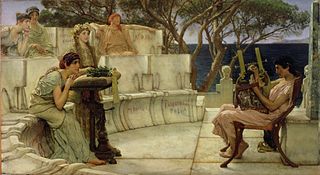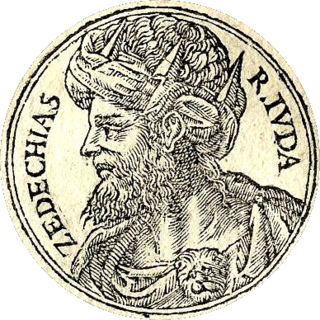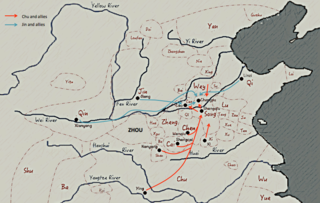Births
This section is empty.You can help by adding to it.(August 2013) |
| Millennium: | 1st millennium BC |
|---|---|
| Centuries: | |
| Decades: | |
| Years: |
| 597 BC by topic |
| Politics |
|---|
| Categories |
| Gregorian calendar | 597 BC DXCVI BC |
| Ab urbe condita | 157 |
| Ancient Egypt era | XXVI dynasty, 68 |
| - Pharaoh | Necho II, 14 |
| Ancient Greek era | 45th Olympiad, year 4 |
| Assyrian calendar | 4154 |
| Balinese saka calendar | N/A |
| Bengali calendar | −1189 |
| Berber calendar | 354 |
| Buddhist calendar | −52 |
| Burmese calendar | −1234 |
| Byzantine calendar | 4912–4913 |
| Chinese calendar | 癸亥年 (Water Pig) 2100 or 2040 — to — 甲子年 (Wood Rat) 2101 or 2041 |
| Coptic calendar | −880 – −879 |
| Discordian calendar | 570 |
| Ethiopian calendar | −604 – −603 |
| Hebrew calendar | 3164–3165 |
| Hindu calendars | |
| - Vikram Samvat | −540 – −539 |
| - Shaka Samvat | N/A |
| - Kali Yuga | 2504–2505 |
| Holocene calendar | 9404 |
| Iranian calendar | 1218 BP – 1217 BP |
| Islamic calendar | 1255 BH – 1254 BH |
| Javanese calendar | N/A |
| Julian calendar | N/A |
| Korean calendar | 1737 |
| Minguo calendar | 2508 before ROC 民前2508年 |
| Nanakshahi calendar | −2064 |
| Thai solar calendar | −54 – −53 |
| Tibetan calendar | 阴水猪年 (female Water-Pig) −470 or −851 or −1623 — to — 阳木鼠年 (male Wood-Rat) −469 or −850 or −1622 |
The year 597 BC was a year of the pre-Julian Roman calendar. In the Roman Empire, it was known as year 157 Ab urbe condita . The denomination 597 BC for this year has been used since the early medieval period, when the Anno Domini calendar era became the prevalent method in Europe for naming years.
This section is empty.You can help by adding to it.(August 2013) |
This section is empty.You can help by adding to it.(August 2013) |
The 6th century BC started the first day of 600 BC and ended the last day of 501 BC.
Year 202 BC was a year of the pre-Julian Roman calendar. At the time it was known as the Year of the Consulship of Geminus and Nero. The denomination 202 BC for this year has been used since the early medieval period, when the Anno Domini calendar era became the prevalent method in Europe for naming years.
The year 586 BC was a year of the pre-Julian Roman calendar. In the Roman Empire, it was known as year 168 Ab urbe condita. The denomination 586 BC for this year has been used since the early medieval period, when the Anno Domini calendar era became the prevalent method in Europe for naming years.

This article concerns the period 599 BC – 590 BC.
Year 228 BC was a year of the pre-Julian Roman calendar. At the time it was known as the Year of the Consulship of Ruga and Verrucosus. The denomination 228 BC for this year has been used since the early medieval period, when the Anno Domini calendar era became the prevalent method in Europe for naming years.

Zedekiah also known as Tzidkiyahu originally called Mattanyahu or Mattaniah, was the twentieth and last king of Judah before the destruction of the kingdom by King Nebuchadnezzar II of Babylon. Zedekiah had been installed as king of Judah by Nebuchadnezzar II, king of Babylon, after a siege of Jerusalem in 597 BC, to succeed his nephew, Jehoiachin, who was overthrown as king after a reign of only three months and ten days.

The year 512 BC was a year of the pre-Julian Roman calendar. In the Roman Empire, it was known as year 242 Ab urbe condita. The denomination 512 BC for this year has been used since the early medieval period, when the Anno Domini calendar era became the prevalent method in Europe for naming years.
The year 600 BC was a year of the pre-Julian Roman calendar. In the Roman Empire, it was known as year 154 Ab urbe condita. The denomination 600 BC for this year has been used since the early medieval period, when the Anno Domini calendar era became the prevalent method in Europe for naming years.

Spring and Autumn period was a period in Chinese history from approximately 771 to 476 BC which corresponds roughly to the first half of the Eastern Zhou period. The period's name derives from the Spring and Autumn Annals, a chronicle of the state of Lu between 722 and 479 BC, which tradition associates with Confucius.

Jin, originally known as Tang (唐), was a major state during the middle part of the Zhou dynasty, based near the centre of what was then China, on the lands attributed to the legendary Xia dynasty: the southern part of modern Shanxi. Although it grew in power during the Spring and Autumn period, its aristocratic structure saw it break apart when the duke lost power to his nobles. In 453 BC, Jin was split into three successor states: Han, Zhao and Wei. The Partition of Jin marks the end of the Spring and Autumn Period and the beginning of the Warring States period.

Qin was an ancient Chinese state during the Zhou dynasty. Traditionally dated to 897 B.C., it took its origin in a reconquest of western lands previously lost to the Rong; its position at the western edge of Chinese civilization permitted expansion and development that was unavailable to its rivals in the North China Plain. Following extensive "Legalist" reform in the 3rd century BC, Qin emerged as one of the dominant powers of the Seven Warring States and unified the seven states of China in 221 BC under Qin Shi Huang. The Qin Dynasty it established was short-lived but greatly influenced later Chinese history.
The year 595 BC was a year of the pre-Julian Roman calendar. In the Roman Empire, it was known as year 159 Ab urbe condita. The denomination 595 BC for this year has been used since the early medieval period, when the Anno Domini calendar era became the prevalent method in Europe for naming years.

The Battle of Chengpu took place in 632 BC between the State of Jin and the State of Chu and its allies during the Spring and Autumn period of Chinese history. It was the first great battle in the protracted conflict between the states of the Yellow River valley, and the states of the Yangtze River valley. The Jin victory confirmed the hegemony of Duke Wen and checked Chu ambitions in the north for at least a generation.
The year 575 BC was a year of the pre-Julian Roman calendar. In the Roman Empire, it was known as year 179 Ab urbe condita. The denomination 575 BC for this year has been used since the early medieval period, when the Anno Domini calendar era became the prevalent method in Europe for naming years.

The Battle of Bi was fought during the Spring and Autumn period in 597 BC, between the major states of Chǔ and Jìn, in what is now modern day China. Occurring three and a half decades after the Battle of Chengpu, where Jin decisively defeated Chu, the battle was a major victory for Chu, cementing the position of its ruler King Zhuang as a hegemon among the states of the Zhou Dynasty.

The Siege of Jerusalem was a military campaign carried out by Nebuchadnezzar II, king of Babylon, in 597 BC. In 605 BC, he defeated Pharaoh Necho at the Battle of Carchemish, and subsequently invaded Judah. According to the Nebuchadnezzar Chronicle, King Jehoiakim of Judah rebelled against Babylonian rule, but Nebuchadnezzar captured the city and installed Zedekiah as ruler.
King Gong of Chu was from 590 to 560 BC the king of Chu, a major power during the Spring and Autumn period of ancient China. He was born Xiong Shen, and at the age of 10 succeeded his father King Zhuang of Chu, who was the Hegemon of China. However, in 575 BC King Gong was defeated by Chu's archrival Jin in the Battle of Yanling and Chu's power declined. He ruled for 31 years and was succeeded by his eldest son, King Kang of Chu. Three of King Gong's younger sons also ascended the throne, all by treacherous means.
King Kang of Chu was from 559 to 545 BC the king of Chu, a major power during the Spring and Autumn period of ancient China. Born Xiong Zhao, he succeeded his father King Gong of Chu. His reign was marked by constant wars with Jin, Chu's traditional enemy, and Wu, its new enemy. He ruled for 15 years and was succeeded by his son, Jia'ao, who would four years later be murdered by King Kang's younger brother King Ling of Chu.
Duke Jing of Jin was from 599 to 581 BC the ruler of the State of Jin, a major power during the Spring and Autumn period of ancient China. His ancestral name was Ji, given name Ju, and Duke Jing was his posthumous title. He succeeded his father Duke Cheng of Jin, who died in 600 BC.
Han Jue, posthumously known as Han Xianzi, was the fifth head of the House of Han and a Jin politician and general. He was the son of Ziyu of Han. Han Jue's father died early and he was raised by Zhao Dun (赵盾), a senior Jin minister. Han Jue later became sima (司马), the minister of war, on Zhao Dun's recommendation. As sima, Han participated in the Battle of Bi and the Battle of An. According to the Zuozhuan, Ziyu appeared to Han Jue in a dream the night before the Battle of An and warned him not to ride in the left or right side of the chariot to avoid being killed by Duke Qing of Qi. During the battle, the soldiers to Han Jue's left and right were shot by arrows. In 583 BC, he supported Zhao Dun's grandson, Zhao Wu (赵武), to head the House of Zhao. In the Battle of Masui, Han commanded the Jin left wing. During the Battle of Yanling, he again commanded the Jin left wing and led a successful flanking maneuver against Chu. In 573 BC, he became Jin's zhengqing (正卿), the highest ministerial office in Ancient China. Han Jue retired in 566 BC due to old age.
| This BC year article is a stub. You can help Wikipedia by expanding it. |